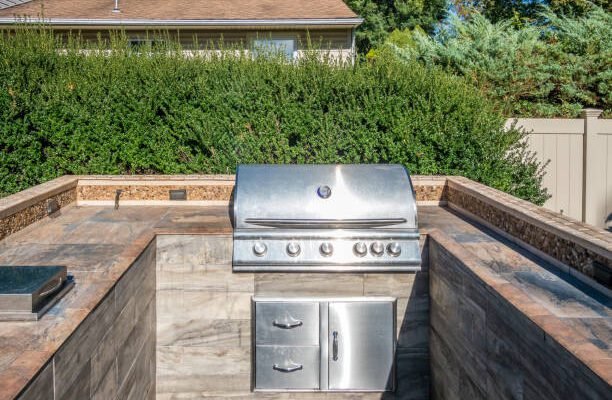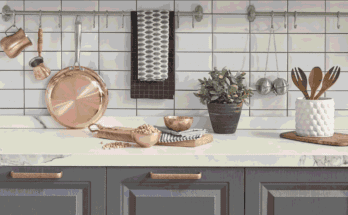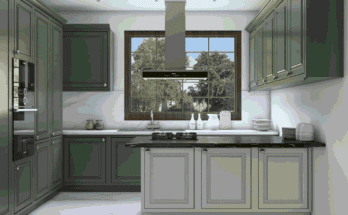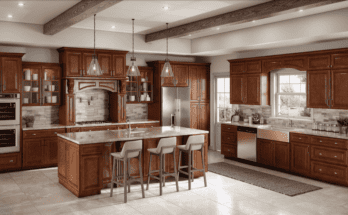1. Introduction
Outdoor kitchens are the new focus of backyard activities, and an appealing, long-lasting countertop is crucial to the image. Selecting an appropriate outdoor kitchen countertop will improve your culinary experience, endure harsh weather conditions and improve the beauty of your outdoor kitchen.
This article is an attempt to provide a brief overview of the available variants of outdoor kitchen countertops, and guidelines on how to properly choose one depending on its durability, style, price and the amount of time it would require to maintain.
2. Choosing the Right Outdoor Countertop Material
Regarding materials used for outdoor kitchen countertops, there are definite differences between them. As with most choices that have to do with home decor, or design in general, factors such as weather resistance, durability, and looks have to be taken into account when choosing between the two.
Factors to Consider
- Weather Resistance: Is it viable to take the material through heat and pressure, through rain, or temperature changes?
- Durability: Is it strong enough to allow me to cook frequently and use it every day?
- Aesthetics: Does the material suit your outside area?
3. Granite Countertops
Granite is standard for its sophistication and strength, thus making it ideal for installation in outdoor kitchens.
Pros and Cons
- Pros: Very hard-wearing, waterproof and comes in lots of colours.
- Cons: Can cost a bit of money and also should be sealed to avoid any form of staining.
Maintenance Tips
Should be washed with mild soap and water, and should be sealed at least once a year to prevent moisture seepage and stains.
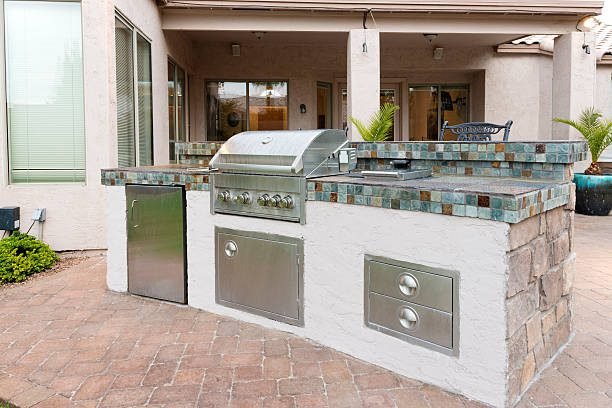
4. Concrete Countertops
It is versatile; a homeowner is able to select preferred colours, surface finish and geometrical shapes on the concrete surface.
Advantages of Using Concrete
Concrete flooring is a low-cost solution, durable and can be coloured or textured in various patterns.
Styling and Customization Options
Concrete can be coloured with different hues and placed on a variety of surfaces, objects such as stones or glass can be added to concrete.
5. Stainless Steel Countertops
Stainless steel is modern looking and adds well to any modernist design of the outdoor kitchens.
Benefits and Challenges
- Benefits: It is heat, weatherproof and easy to maintain through non-stick to stain.
- Challenges: Scratchable and gets hot with sunlight exposure.
Ideal Climate and Usage Scenarios
6. Tile Countertops
Tile countertops are easier on the pocket, and the number of available options when it comes to patterns and colour is almost limitless.
Ceramic and Porcelain Tile Pros and Cons
- Pros: Cheap, vibrant and when damaged, require a simple fix.
- Cons: Grout lines are usually dirty and generally, tiles may crack if too much pressure is applied to them.
Tips for Tile Maintenance
It is recommended to clean the sealed grout often for stains, but for normal cleaning, one must use a mild cleaner.
7. Soapstone Countertops
Soapstone is the most traditional looking and it has no need for sealing – it is ideal for the outdoors.
Unique Properties of Soapstone
Non-stick, heat and bacteria-resistant, which makes it a good ideal for use in outside barbecuing.
Pros, Cons, and Best Care Practices
- Pros: Does not need to be sealed, and even through normal wear that creates scratches they can be sanded out.
- Cons: Slightly flexible and easy to scratch but can be sanded back to repair.
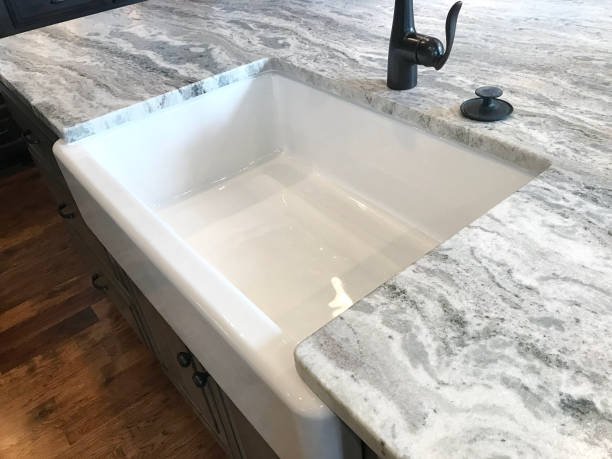
8. Wooden Countertops
To get that warm and natural look in your outside cooking area, you might consider using wooden countertops.
Wood Types Suitable for Outdoor Use
Teak, cedar and ipe are used often because of their high resistance to rotting and moisture.
Maintenance and Sealing for Durability
Tight-jointed and must be sealed annually to prevent them from wearing out due to the effects of weather.
9. Quartz Countertops
Interestingly, many people use quartz in their indoor kitchens but may not recommend it for outdoor kitchens because it fades when exposed to sunlight and heat.
Alternative Stone Options
Granite or concrete may be used to achieve the same effect but with better performance in exterior spaces.
10. Best Countertops for Different Climates
Another factor that plays a big role in making this decision is the climate prevailing in the building’s location because using the right material has a long lifespan and little need for maintenance.
Hot Climates
High temperatures do not discolour granite, concrete or stainless steel.
Humid Climates
Tiles are easy to clean and will not accommodate mould growth, as well as the soapstone which is moisture-proof.
Freezing Temperatures
Freeze resistance is also present because of granite and concrete which is good for areas experiencing severe cold.
11. Cost Comparison of Countertop Materials
Knowing your budget is important when it comes to choosing your countertop material.
Budget-Friendly vs. High-End Options
Being the most common natural stones, tile and concrete are relatively inexpensive as compared to the highly valued granite and costly stainless steel.
Comparing Installation and Maintenance Costs
They should also look at the first and the recurring costs so that they know that some materials call for frequent maintenance.
12. Popular Outdoor Countertop Design Trends
Outdoor kitchen countertops have not been left out by new trends and styles that exist majorly for the enhancement of backyard looks.
Minimalist and Modern Designs
Contemporary appearance is achieved due to shiny finish and material such as stainless steel combined with concrete.
Rustic and Natural Stone Options
Soapstone and woods give much warmth to the countryside feeling.
Sustainable and Eco-Friendly Countertops
Where possible, include post-consumer recycled content and use regional suppliers to choose the lowest global warming potential materials on the market.
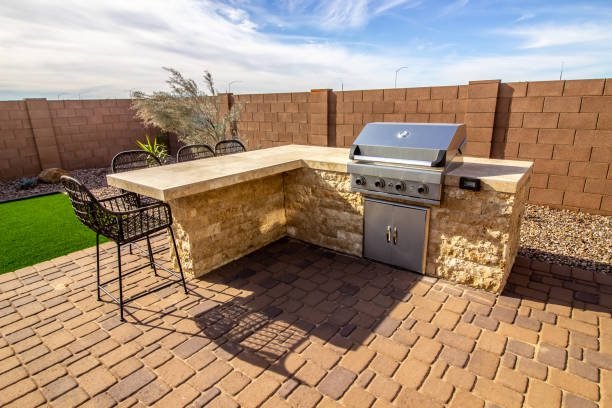
13. DIY vs. Professional Installation
Some countertops types can probably be placed by the homeowner themselves while others will need professional help.
Pros and Cons of DIY Installation
Do it yourself can be done to address some pros such as cutting down on expenses but it may lead to a lot of time and a lot of skill being used.
When to Hire a Professional
This remains the case when dealing with such materials as granite or stainless steel where professional installation guarantees fixture durability and precision.
14. Maintenance Tips for Long-Lasting Outdoor Countertops
High-quality maintenance will make Your outdoor countertop to have a longer life and maintain the aesthetically pleasing look.
Cleaning Routine
Do not use chemicals to clean as they can stain or even permanently corrode the surface of your swimming pool.
Preventive Measures for Weather Protection
Use a cover on countertops always when not in use and where needed apply an application of a sealant on the countertop.
15. Expert Insights on Outdoor Kitchen Countertops
Experts emphasize selecting materials suited to your climate and lifestyle for durability.
Quotes from Designers and Contractors
“Granite and soapstone are ideal choices for outdoor kitchens due to their durability and low maintenance.” – Outdoor Kitchen Designer
16. Future Trends in Outdoor Kitchen Countertops
This is the reason why innovation has been the main driver of new materials and technologies for use in outdoor kitchens.
Innovative Materials on the Rise
Greater development of new composites that are more weatherproof and designs that are more sustainable for the earth’s environment are in the offing.
17. Conclusion
Selecting the best material for counters is critical to the efficiency and aesthetics of a great outdoor cooking area. No matter if you choose wood or stainless steel, there are advantages and disadvantages to using each material for your home. Do not forget the exposure of your countertop to climatic conditions, the level of care you will be able to afford, and the costs you will incur so you may be able to have the best countertop for years.
FAQ’s
[saswp_tiny_multiple_faq headline-0=”h3″ question-0=”1. What is the best countertop material for outdoor kitchens?” answer-0=”Granite and concrete are popular choices due to their durability and resistance to outdoor elements. ” image-0=”” headline-1=”h3″ question-1=”2. Can quartz be used for outdoor kitchen countertops?” answer-1=”Quartz is not ideal for outdoor use as it can discolor under sunlight and doesn’t tolerate high temperatures well. ” image-1=”” headline-2=”h3″ question-2=”3. How do I maintain my outdoor countertop?” answer-2=”Use non-abrasive cleaners, seal porous materials annually, and cover when not in use to protect against weather. ” image-2=”” headline-3=”h3″ question-3=”4. Are stainless steel countertops good for outdoor kitchens?” answer-3=”Stainless steel is durable, heat-resistant, and perfect for modern outdoor kitchens, though it may retain heat in direct sunlight. ” image-3=”” headline-4=”h3″ question-4=”5. What countertop material is best for humid climates?” answer-4=”Soapstone and tile are excellent for humid climates due to their natural resistance to mold and moisture.” image-4=”” count=”5″ html=”true”]

